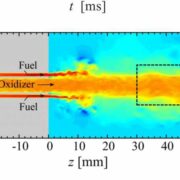VLT GRAVITY: First Direct Observation of β Pictoris C an Exoplanet

Astronomers using the GRAVITY instrument at the VLT telescopes in Chile have now obtained the primary direct confirmation of an exoplanet discovered by radial-velocity. because the planet “β Pictoris c” is during a close orbit around its parent star, this is often the primary time that the faint glint of the exoplanet next to the glare of the star has been directly observed. With these observations, astronomers can obtain both the flux and dynamical masses of exoplanets, allowing them to place closer constrains on formation models for exoplanets.
Combining the sunshine of the four large VLT telescopes, astronomers within the GRAVITY collaboration have managed to directly observe the glint of sunshine coming from an exoplanet on the brink of its parent star. the earth called “β Pictoris c” is that the second planet found to orbit its parent star. it had been originally detected by the so-called ‘radial velocity’, which measures the drag and pull on the parent star thanks to the planet’s orbit. β Pictoris c is so on the brink of its parent star that even the simplest telescopes weren’t ready to directly image the earth thus far .
“This is that the first direct confirmation of a planet detected by the speed method,” says Sylvestre Lacour, leader of the ExoGRAVITY observing program. speed measurements are used for several decades by astronomers, and have allowed for the detection of many exoplanets. But never before were the astronomers ready to obtain an immediate observation of 1 of these planets. This was only possible because the GRAVITY instrument, situated during a laboratory underneath the four telescopes it uses, may be a very precise instrument. It observes the sunshine from the parent star with all four VLT telescopes at an equivalent time and combines them into a virtual telescope with the detail required to reveal β Pictoris c.
“It is amazing, what level of detail and sensitivity we will achieve with GRAVITY,” marvels Frank Eisenhauer, the lead scientist of the GRAVITY project at MPE. “We are just beginning to explore stunning new worlds, from the supermassive region at the middle of our galaxy to planets outside the system .”
The direct detection with GRAVITY, however, was only possible thanks to new speed data precisely establishing the orbital rotation of β Pictoris c, presented during a second paper published also today. This enabled the team to exactly pinpoint and predict the expected position of the earth in order that GRAVITY was ready to find it.
β Pictoris c is thus the primary planet that has been detected and confirmed with both methods, speed measurements and direct imaging. additionally to the independent confirmation of the exoplanet, the astronomers can now combine the knowledge from these two previously separate techniques. “This means, we will now obtain both the brightness and therefore the mass of this exoplanet,” explains Mathias Nowak, the lead author on the GRAVITY discovery paper. “As a general rule, the more massive the earth , the more luminous it’s .”
In this case, however, the info on the 2 planets is somewhat puzzling: the sunshine coming from β Pictoris c is sixfold fainter than its larger sibling, β Pictoris b. β Pictoris c has 8 times the mass of Jupiter. So how massive is β Pictoris b? speed data will ultimately answer this question, but it’ll take an extended time to urge enough data: one full orbit for planet b around its star takes 28 of our years!
“We used GRAVITY before to get spectra of other directly imaged exoplanets, which themselves already contained hints on their formation process,” adds Paul Molliere, who as postdoc at MPIA is modelling exoplanet spectra. “This brightness measurement of β Pictoris c, combined with its mass, may be a particularly important step to constraining our planet formation models.” Additional data may additionally be provided by GRAVITY+, subsequent generation instrument, which is already under development.

























